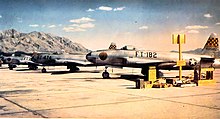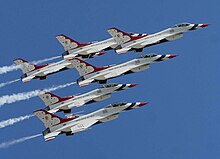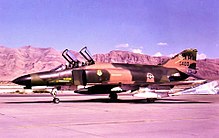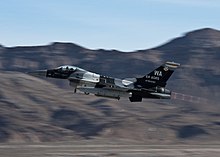Nellis Air Force Base
| Nellis Air Force Base | |||||||||
|---|---|---|---|---|---|---|---|---|---|
United States of America | |||||||||
 An aerial view of Nellis AFB taken in 2014 | |||||||||
 | |||||||||
| Coordinates | 36°14′57″N 114°59′46″W / 36.24917°N 114.99611°W[1] | ||||||||
| Type | US Air Force base | ||||||||
| Area | 4,600 ha (11,300 acres) | ||||||||
| Site information | |||||||||
| Owner | Department of Defense | ||||||||
| Operator | United States Air Force | ||||||||
| Controlled by | Air Combat Command (ACC) | ||||||||
| Open to the public | Yes, with restrictions (Thunderbirds Museum and tours) | ||||||||
| Condition | Operational | ||||||||
| Website | Official website | ||||||||
| Site history | |||||||||
| Built | 1941 (as Las Vegas Army Airfield) | ||||||||
| In use | 1941 – present | ||||||||
| Garrison information | |||||||||
| Current commander | Colonel Todd Dyer | ||||||||
| Garrison | 99th Air Base Wing (Host) | ||||||||
| Occupants |
| ||||||||
| Airfield information | |||||||||
| Identifiers | AMSL | ||||||||
| |||||||||
| Source: Federal Aviation Administration[2] | |||||||||
Nellis Air Force Base ("Nellis"
History
After
McCarran Field
Renamed to McCarran Field in the mid-1930s,
Las Vegas Army Airfield
Las Vegas Army Airfield was both activated and began flying training on 20 December 1941.[11] Gunnery training began in January 1942, with guntruck platforms being used in January and February.[9].: 2–3 [6] Many pieces of the destroyed aerial drone targets litter the hillside north of the gunnery range, and can be seen in town when the sun reflects off them.[citation needed]
The first
In March 1945, the base switched to

Las Vegas Air Force Base
Renamed Las Vegas Air Force Base on 13 January 1948
Nellis AFB

Nellis Air Force Base was named on 30 April 1950, and the 20 May 1950 dedication was attended by
USAF Fighter Weapons School
The USAF Fighter Weapons School was designated on 1 January 1954 from the squadron[verification needed] when the Air Crew School graduated its last Combat Crew Training Class (the primary Weapons School mission was gunnery instructor training).[13] In the mid-1950s for Operation Teapot nuclear testing, 1 of the 12 Zone Commanders was based at Nellis AFB for community liaison/public relations[17] (weapons for other atomic tests were stored at Nellis).[citation needed] Air Training Command suspended training at the Nellis fighter weapons school in late 1956 because of the almost total failure[clarification needed] of the F-86 Sabre aircraft used at Nellis,[13] and during 1958 ATC discontinued its Flying Training and Technical Training.
Tactical Air Command
Nellis AFB transferred to Tactical Air Command on 1 February 1958,
4520th Combat Crew Training Wing
The 4520th Combat Crew Training Wing was designated from the 4520th CCTG on 1 May 1961, and the Combat Crew training squadrons were renumbered.
USAF Tactical Fighter Weapons Center
The
The FWC supervised Red Flag operational training and other continuing air exercises, such as Green Flag and Silver Flag Alpha. The center also directed operations of the US Air Force
474th Tactical Fighter Wing
The
The 430th TFS returned to the 474th TFW Nellis on 22 March 1973 assuming a replacement training unit mission, while the 428th and 429th were transferred to
57th Fighter Weapons Wing

The
Nellis'

The
In 1981, the Gunsmoke gunnery meet was first held[6] and the 57th Fighter Weapons Wing was reorganized as part of the establishment of the Fighter Weapons School, e.g., the 422d Test and Evaluation Squadron for aircraft modifications was established on 30 December 1981 from the 422d Fighter Weapons Squadron. In 1990, the 64th and 65th Tactical Fighter Training Aggressor Squadrons and the 4440th TFTG were inactivated in 1990 at the end of the Cold War.[19] In November 1991, the 57th implemented the USAF Objective Wing organization which was the most comprehensive USAF reorganization plan since 1947,[27] activating the 57th Operations Group for Nellis airfield operations and establishing the 57th Test Group.[21]
Air Combat Command

Nellis transferred to Air Combat Command on 1 June 1992,
The 57th Adversary Tactics Group merged into the 57th Operations Group on 31 March 2020.[30] On 1 June 2020 the 800th Rapid Engineer Deployable, Heavy Operational Repair Squadron, Engineer (RED HORSE) Group activated at Nellis, with the 820th Red Horse Squadron as a subordinate unit.[31]
Major commands to which assigned
- West Coast Air Corps Training Center, April 1941
- Air Corps Flying Training Command, 23 January 1942 and various subsequent designations through Air Training Command, 1 July – 31 December 1946, 30 August 1947
- Tactical Air Command, 1 July 1958
- Air Combat Command, 1 June 1992 – present
Major units assigned
- 79th Air Base Group, 7 July 1941
- 70th Base HQ and Air Base Squadron, c. 14 August 1942
- 82d Flying Training Wing (Flexible Gunnery) 8 January 1943 – 16 June 1946
- 3595th Pilot Training Wing, 1 April 1948[11]: 54 – 1 July 1958
- 4520th Combat Crew Training Wing, 1 July 1958 – 1 September 1966
- 4525th Fighter Weapons Wing, 1 September 1966 – 15 October 1969
- 474th Tactical Fighter Wing, 20 January 1968 – 15 October 1989
- 57th Wing (Various Designations), 22 August 1969 – present
- 554th Operations Support Wing, 1 March 1980 – 1 November 1995
- USAF Fighter Weapons School, 1 January – 1 September 1966; 30 December 1981 (USAF Weapons School on 15 June 1993)
- 4477th Tactical Evaluation Flight ("Red Eagles"), 1 April 1975 – 1990
- USAF Tactical Fighter Weapons Center, 1 September 1966[32] (USAF Warfare Center on 15 November 2005)
Role and operations
Nellis Air Force Base is known by the USAF as the "Home of the Fighter Pilot" and is the Air Force's focus for advanced combat training. The main unit at Nellis is the USAF Warfare Center, which coordinates training for composite strike forces involving aircraft types from across the USAF inventory, accompanied by air and ground units of the US Army, US Navy, US Marines, and aircraft from other NATO and allied nations. Training is delivered through a series of exercises which typically take place at the Nevada Test and Training Range (NTTR), the primary examples being Exercise Red Flag and Exercise Green Flag (West).[33]
As of October 2019, Nellis employed 9,500 military and civilian personnel. The total military population is more than 40,000, including family members and retired military personnel in the area.[33]
The base also supports operations at nearby
Nellis Area I has the airfield (2 runways and ramp space for up to 300 aircraft), recreation and shopping facilities, dormitories/temporary lodging, some family housing,: 5–38
Based units
Flying and notable non-flying units based at Nellis Air Force Base.[36][37][38][39][40]
Units marked GSU are Geographically Separate Units, which although based at Nellis, are subordinate to a parent unit based at another location.
United States Air Force
|
Air Force Materiel Command (AFMC)
Air Force Reserve Command (AFRC)
Air National Guard (ANG)
Department of DefenseUnited States Strategic Command
|
Geography
Nellis AFB covers about 4,600 ha (11,300 acres) in the northeast corner of the
| Census | Pop. | Note | %± |
|---|---|---|---|
| 1970 | 6,449 | — | |
| 1980 | 6,205 | −3.8% | |
| 1990 | 8,377 | 35.0% | |
| 2000 | 8,896 | 6.2% | |
| 2010 | 3,187 | −64.2% | |
| [41] | |||
Census-designated place
The Nellis Air Force Base CDP is an 8.0 km2 (3.1 sq mi) region defined by the
Nellis AFB complex
The
In popular culture
- A scaled-down version of Nellis Air Force Base appears in the 2010 video game Fallout: New Vegas.
- The base is briefly shown in the 2007 film Transformers, where Captain William Lennox and Sergeant Robert Epps are contacted by Sector 7.
- The base is briefly mentioned at the end of Terminator 3: Rise of the Machines (2003). The base is said to be under attack from the machines.
See also
- List of United States Air Force installations
- Nevada World War II Army Airfields
Notes
- ^ a b "Geographic Names Information System" (search page). USGS. Retrieved 6 June 2013.: Nellis AFB "Airport" (2443876, 361408N 1150224W),
Nellis AFB CDP (2408911, 361448N 1150326W),
Nellis Air Force Base (2511960, 361457N 1145946W),
Nellis AFB Post Office (865017, 361432N 1150244W, 01-MAY-1992),
Community College of Southern Nevada Nellis Air Force Base Center (2087468) - ^ "Airport Diagram – Nellis AFB (KLSV)" (PDF). Federal Aviation Administration. 15 August 2019. Archived from the original (PDF) on 28 August 2019. Retrieved 1 September 2019.
- ^ a b c Huntley, Chris, Proj. Mgr. (August 2008). …Patriot Communications Exercises in Lincoln County, Nevada (PDF) (Report). Vol. AFD-081006-078. Aspen Environmental Group. pp. 3–28. Archived from the original (Final Environmental Assessment) on 4 March 2013. Retrieved 6 February 2013.
{{cite report}}: CS1 maint: multiple names: authors list (link) - ISBN 0-912799-38-2.
- ^ a b c Futrell, Robert F. (July 1947). Development of AAF Base Facilities in the United States: 1939–1945 (Report). Vol. ARS-69: US Air Force Historical Study No 69 (Copy No. 2). Air Historical Office.
Difficulties in securing the use of the gunnery ranges at Las Vegas, Nevada, and Tyndall Field, Florida, delayed the beginning of flexible gunnery training at those stations until December 1941
- ^ ISBN 978-0760325308. Retrieved 10 June 2013.
- ^ Final Inventory Project Report, Tonopah Bombing Range (Report). Project Number – J09NV1114. USACE Sacramento District. September 1999.
Executive order 8578 was executed on October 29, 1940 for the withdrawal of 3,560,000 million acres (1.44×1010 km2) of land from the public domain for use by the War Department as an aerial bombing and gmnery range (CE0769).
- ^ a b c d "Nellis Air Force Base, Nevada". The Military Standard – Air Force Bases. TechBastard.com. Retrieved 6 June 2013.
- ^ a b c d e f g h i j k l m Comprehensive Site Evaluation Phase II (PDF) (Report). June 2010. Archived from the original (PDF) on 3 March 2013. Retrieved 8 June 2013.
- ^ "Las Vegas' Past". NetPhilosophy.Com. Archived from the original on 13 February 2009. Retrieved 8 November 2008.
- ^ tbd. Retrieved 9 June 2013.
Installations Las Vegas Field, Nevada Air Training Command inactivated the base on 31 December 1946. From its activation on 20 December 1941, Las Vegas AAF had conducted flying training.
- ^ "The Rear Gunner". Internet Movie Database. 10 April 1943.
- ^
- ^
- ^ ISBN 0-912799-53-6. Retrieved 6 June 2013.
- ^ "Lieutenant William Harrell Nellis". Nellis AFB Public Affairs. Archived from the original (fact sheet) on 29 December 2010. Retrieved 10 June 2013.
Posted 7/12/2012
- ^ Operation Teapot report
- Aviation Safety Network
- ^ ISBN 0-88740-513-4.
- ^ Wilman, J. Catherene (1997). A Pictorial History of Nellis Air Force Base 1941–1996. Nellis AFB Office of History.
- ^ a b c d e f g h i "Nellis AFB Factsheet". 57th Wing/PA. Archived from the original on 10 June 2011.
- ^ ISBN 1-85532-259-5
- ^ Davies, Steve (2008). Red Eagles. America's Secret MiGs. Osprey Publishing.
- ^ "Constant Peg". Air Force Magazine. 90 (4). April 2007.
- LCCN 97020912. Archived from the originalon 1 December 2012. Retrieved 23 April 2013.
- ^ a b Robertson, Patsy. "USAF Weapons School (ACC)". Archived from the original (AFHRA fact sheet) on 20 February 2013. Retrieved 10 June 2013.
Posted 8/19/2009
- ^ ISBN 1-85780-197-0.
- ISBN 978-0-8330-3412-0.
- ^ "Combined Air and Space Operations Center-Nellis". Public Affairs, 505th Command and Control Wing. Archived from the original (fact sheet) on 18 February 2013. Retrieved 6 June 2013.
Posted 3/3/2010
- ^ West, Master Sgt. Heidi (3 April 2020). "57th OG, ATG merge functions, streamlines mission readiness". US Air Force. Retrieved 1 May 2020.
- ^ "800th RED HORSE Group". 15th Air Force. US Air Force. Retrieved 21 August 2020.
- ^ Kane, Robert B. (20 July 2010). "USAF Warfare Center (ACC)". AFHRA. Archived from the original (U.S. Air Force Fact Sheet) on 18 March 2013.
- ^ a b "Fact Sheet – Nellis Air Force Base". Nellis Air Force Base. US Air Force. October 2019. Retrieved 26 May 2020.
- ^ "Nellis Based Exercises". DreamLandResort.com.
- ^ "Nellis Air Force Base - Sports and Fitness". Archived from the original on 27 May 2013. Retrieved 13 June 2013.
- ^ "Nellis Air Force Base Fact Sheet". Nellis Air Force Base. US Air Force. October 2019. Retrieved 16 March 2022.
- ^ "Nevada Test and Training Range". Nellis Air Force Base. US Air Force. November 2021. Retrieved 16 March 2022.
- ^ "Aircraft and Squadrons of the US Air Force". United States Air Force Air Power Review 2020. Key Publishing: 74–92. 2020.
- ^ Gamboa, Staff Sgt. Sergio A. (15 June 2020). "Detachment 1, 355th Wing activated at Nellis". Davis-Monthan Air Force Base. US Air Force. Retrieved 25 June 2020.
- ^ "Units". 152nd Airlift Wing. US Air Force. Retrieved 16 March 2022.
- U.S. Census Bureau. Retrieved 25 July 2010.
- ^ "List of [FUDS] Sites…". CorpsFUDS.org. Archived from the original (sorted database query list) on 15 June 2013. Retrieved 10 June 2013.
- ^ Table C-3 Status of Installations With Response Completed
References
- Manning, Thomas A. (2005), History of Air Education and Training Command, 1942–2002. Office of History and Research, Headquarters, AETC, Randolph AFB, Texas
- Ravenstein, Charles A. (1984). Air Force Combat Wings Lineage and Honors Histories 1947–1977. Maxwell AFB, Alabama: Office of Air Force History. ISBN 0-912799-12-9.
- Shaw, Frederick J. (2004), Locating Air Force Base Sites, History’s Legacy, Air Force History and Museums Program, United States Air Force, Washington DC. OCLC 57007862, 1050653629
External links
- Official website

- Desert Lightning News (southern Nevada edition) – base newspaper
- Hanson, Robert A. (1 January 2002). "Air Combat U - At the USAF Fighter Weapons School in 1957, the instructors were mean, but the aircraft were meaner". Air & Space Smithsonian. Archivedfrom the original on 12 April 2019.








